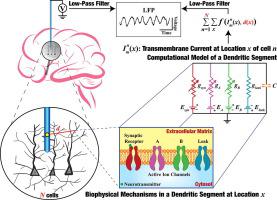Neuroscience ( IF 3.3 ) Pub Date : 2021-09-08 , DOI: 10.1016/j.neuroscience.2021.08.035 Manisha Sinha 1 , Rishikesh Narayanan 1

|
Neurons and glial cells are endowed with membranes that express a rich repertoire of ion channels, transporters, and receptors. The constant flux of ions across the neuronal and glial membranes results in voltage fluctuations that can be recorded from the extracellular matrix. The high frequency components of this voltage signal contain information about the spiking activity, reflecting the output from the neurons surrounding the recording location. The low frequency components of the signal, referred to as the local field potential (LFP), have been traditionally thought to provide information about the synaptic inputs that impinge on the large dendritic trees of various neurons. In this review, we discuss recent computational and experimental studies pointing to a critical role of several active dendritic mechanisms that can influence the genesis and the location-dependent spectro-temporal dynamics of LFPs, spanning different brain regions. We strongly emphasize the need to account for the several fast and slow dendritic events and associated active mechanisms –– including gradients in their expression profiles, inter- and intra-cellular spatio-temporal interactions spanning neurons and glia, heterogeneities and degeneracy across scales, neuromodulatory influences, and activity-dependent plasticity — towards gaining important insights about the origins of LFP under different behavioral states in health and disease. We provide simple but essential guidelines on how to model LFPs taking into account these dendritic mechanisms, with detailed methodology on how to account for various heterogeneities and electrophysiological properties of neurons and synapses while studying LFPs.
中文翻译:

活性树突和 LFP:生物物理机制和计算探索
神经元和神经胶质细胞具有表达丰富的离子通道、转运蛋白和受体的膜。穿过神经元和神经胶质细胞膜的离子的恒定通量导致可以从细胞外基质记录的电压波动。该电压信号的高频分量包含有关尖峰活动的信息,反映了记录位置周围神经元的输出。信号的低频分量,称为局部场电位 (LFP),传统上被认为提供有关突触输入的信息,这些突触输入撞击各种神经元的大树突树。在本次审查中,我们讨论了最近的计算和实验研究,这些研究指出了几种活跃的树突机制的关键作用,这些机制可以影响跨越不同大脑区域的 LFP 的起源和位置依赖的光谱时间动力学。我们强烈强调需要考虑几个快速和缓慢的树突事件和相关的活动机制——包括它们的表达谱中的梯度、跨越神经元和神经胶质的细胞间和细胞内时空相互作用、跨尺度的异质性和退化、神经调节影响和依赖于活动的可塑性——以获得有关健康和疾病不同行为状态下 LFP 起源的重要见解。我们提供了关于如何在考虑到这些树突机制的情况下对 LFP 建模的简单但必不可少的指南,


























 京公网安备 11010802027423号
京公网安备 11010802027423号